Application for Construction Worker Position – Professional Email
Subject: Application for Construction Worker Position
Dear Hiring Manager,
I am writing to express my interest in the Construction Worker position at your company. With over five years of experience in commercial and residential construction, I have developed expertise in site preparation, material handling, and team coordination.
I am particularly skilled in operating heavy machinery, following safety protocols, and ensuring project timelines are met efficiently. I am confident that my experience and dedication will make me a valuable asset to your team.
I would welcome the opportunity to discuss my qualifications further in an interview. Thank you for considering my application.
Sincerely,
[Your Name]
Provisional Installation Technician Application – Casual Email
Subject: Interest in Installation Technician Role
Hi [Hiring Manager's Name],
I hope this message finds you well. I'm reaching out to apply for the Installation Technician role at [Company Name]. I've worked on multiple installation projects over the past three years, including electrical and mechanical setups, and I enjoy hands-on problem-solving.
I believe my practical experience and adaptability make me a good fit for your team. I'd love to chat more about how I can contribute.
Thanks for your time,
[Your Name]
Formal Construction Foreman Application Letter
Subject: Application for Construction Foreman Position
Dear Sir/Madam,
I am writing to formally apply for the Construction Foreman position at your esteemed company. Over the past eight years, I have managed teams of up to 20 workers, overseeing daily operations, scheduling tasks, and ensuring adherence to safety standards.
My background includes coordinating subcontractors, monitoring project budgets, and liaising with clients to guarantee satisfaction. I am confident that my leadership experience and organizational skills will allow me to contribute effectively to your ongoing projects.
I would be honored to discuss this opportunity in detail and provide references from previous employers. Thank you for your time and consideration.
Yours faithfully,
[Your Name]
Heartfelt Application for Entry-Level Construction Role – Email
Subject: Application for Entry-Level Construction Position
Dear [Hiring Manager's Name],
I am excited to apply for the entry-level construction position at your company. Construction work has always been my passion, and I am eager to contribute my energy and dedication to your team.
Though I am at the start of my career, I am highly motivated to learn and adapt quickly. I am confident that my enthusiasm and commitment will make me a reliable team member.
Thank you for considering my application. I look forward to the possibility of joining your team.
Sincerely,
[Your Name]
Quick Job Application for Installation Assistant – Informal Email
Subject: Application for Installation Assistant
Hi [Hiring Manager's Name],
I'm interested in the Installation Assistant position at [Company Name]. I have hands-on experience with assembly and equipment setup, and I work well in fast-paced environments.
Looking forward to hearing from you!
Best,
[Your Name]
Request for Internship in Construction – Simple Email
Subject: Internship Request – Construction Department
Dear [Hiring Manager's Name],
I am writing to request an internship opportunity in your construction department. As a current student studying civil engineering, I am eager to gain practical experience in site management and installation work.
I am committed to learning quickly and assisting wherever needed. I hope to contribute positively while gaining valuable insights from your experienced team.
Thank you for your consideration.
Sincerely,
[Your Name]
Follow-Up Letter for Construction Job Application – Formal
Subject: Follow-Up on Construction Worker Application
Dear [Hiring Manager's Name],
I am writing to follow up on my application for the Construction Worker position submitted on [Date]. I remain very interested in joining your team and would appreciate any updates regarding the hiring process.
Thank you for your time and consideration. I look forward to the possibility of contributing to your projects.
Sincerely,
[Your Name]
What / Why: Purpose of Cover Letters for Construction and Installation Jobs
- A cover letter is a written message sent alongside a CV or resume.
- It introduces the applicant to a potential employer and highlights relevant skills, experiences, and qualifications.
- The purpose is to convince the employer that the candidate is suitable for the role and worthy of an interview.
- In construction and installation jobs, the letter emphasizes practical skills, safety awareness, teamwork, and hands-on experience.
- A strong cover letter increases the chances of standing out among many applicants.
Who Should Send Construction and Installation Cover Letters
- Job seekers actively applying for construction or installation roles.
- Recent graduates seeking entry-level positions in construction.
- Experienced professionals aiming to advance or switch employers.
- Individuals applying for internships or temporary assignments in construction projects.
Whom to Address in Construction and Installation Cover Letters
- Direct hiring managers or HR representatives listed in the job posting.
- If the recipient is unknown, a general title such as "Dear Hiring Manager" can be used.
- For smaller firms, address the owner or project manager directly.
- Ensure the recipient is someone who makes or influences hiring decisions.
When to Send a Cover Letter
- When applying for a new job opening in construction or installation.
- During career fairs or recruitment events when submitting applications.
- When responding to a referral from a current employee.
- For internships, temporary positions, or project-specific roles.
- Even when submitting digitally, include a cover letter unless the employer explicitly states otherwise.
How to Write and Send a Construction/Installation Cover Letter
- Begin with a clear subject line for emails or a title for letters.
- Open with a greeting addressing the hiring manager or HR contact.
- Highlight relevant skills, certifications, and experiences.
- Include specific achievements (e.g., completed projects, safety records, machinery expertise).
- End with a call to action or request for an interview.
- For emails, attach a resume or CV in PDF format.
- Proofread carefully for grammar and clarity before sending.
How Much Detail to Include
- Keep cover letters between 250–400 words.
- Highlight 3–5 key experiences or skills relevant to the role.
- Mention specific certifications or machinery expertise if required.
- Avoid repeating the resume; instead, complement it with context and narrative.
FAQ: Common Questions About Construction Cover Letters
Q: Is a cover letter mandatory for construction jobs?
A: While not always required, it greatly increases your chances of being noticed.
Q: Should I mention salary expectations?
A: Only if requested in the job posting.
Q: Can I use the same letter for multiple applications?
A: You can, but tailor each one to the specific role and company for best results.
Q: How should I address gaps in work experience?
A: Highlight training, volunteer work, or relevant projects during the gap period.
Requirements and Prerequisites Before Sending a Cover Letter
- Updated resume highlighting construction or installation experience.
- List of certifications (e.g., OSHA, electrical licenses, machinery operation).
- Knowledge of the company's projects and operations.
- Proper formatting tools for email or printed letters.
- A clear understanding of the job description and required skills.
Formatting Guidelines
- Length: 1 page maximum (250–400 words).
- Tone: Professional for most jobs, casual for informal or small companies.
- Structure: Opening, body (experience & skills), closing.
- Mode: Email for digital applications, printed letter for in-person or official submission.
- Etiquette: Polite, respectful, and free of slang.
- Font: Standard readable fonts like Arial, Calibri, or Times New Roman.
After Sending: Follow-Up and Confirmation
- Wait 7–10 days before sending a polite follow-up email.
- Confirm receipt if the company provides acknowledgment.
- Keep track of applications and responses in a log.
- Be ready to provide additional documents or references if requested.
Pros and Cons of Sending a Cover Letter
Pros:
- Showcases personality and communication skills.
- Highlights practical experience beyond the resume.
- Can explain career changes or gaps.
Cons:
- Takes additional time to prepare.
- If poorly written, can negatively impact perception.
- May be unnecessary for some online application systems.
Compare and Contrast with Other Application Methods
- Cover Letter vs Resume: Resume lists facts; cover letter tells a story and provides context.
- Cover Letter vs Direct Call: Letters provide formal written evidence; calls are brief and informal.
- Cover Letter vs LinkedIn Message: LinkedIn is shorter and less formal, suitable for networking; cover letters are formal job applications.
Tricks and Tips for Effective Construction Cover Letters
- Use action verbs: managed, supervised, installed, operated.
- Include measurable achievements: "Completed 10+ installation projects ahead of schedule."
- Highlight safety certifications and compliance knowledge.
- Tailor each letter to the specific company and role.
- Keep paragraphs concise and focused.
- End with a strong call to action requesting an interview.
Common Mistakes to Avoid
- Repeating the resume word-for-word.
- Using a generic greeting without personalization.
- Spelling or grammar errors.
- Overly long letters or unnecessary details.
- Ignoring specific job requirements mentioned in the posting.
Essential Elements and Structure
- Subject/Title: Clearly state the role being applied for.
- Opening Greeting: Address the hiring manager appropriately.
- Introduction: Mention why you are applying.
- Body: Highlight experience, skills, achievements, certifications.
- Closing: Express gratitude and request for an interview.
- Signature: Include name and contact details.
- Attachments: Resume, certificates, or reference letters if applicable.
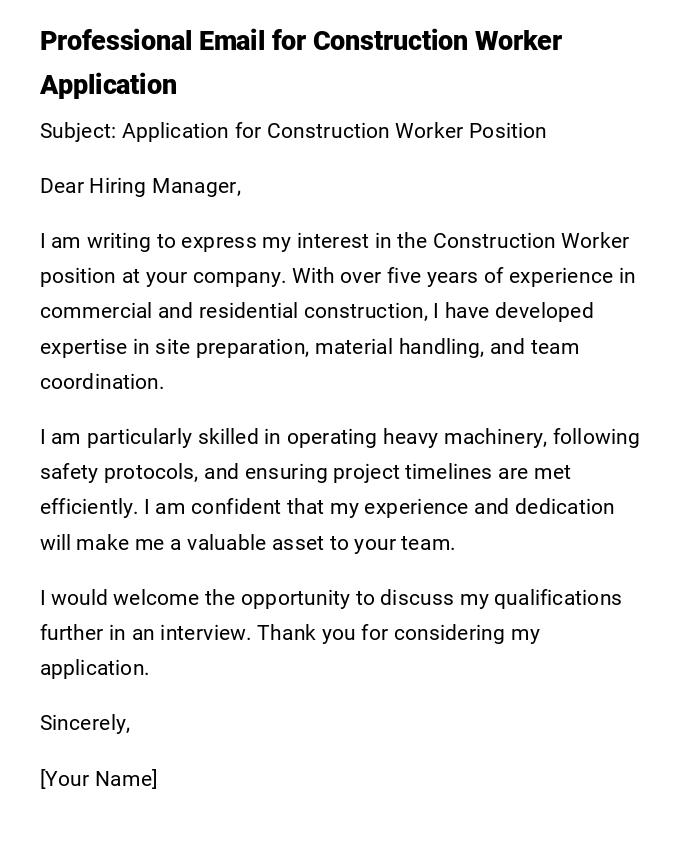
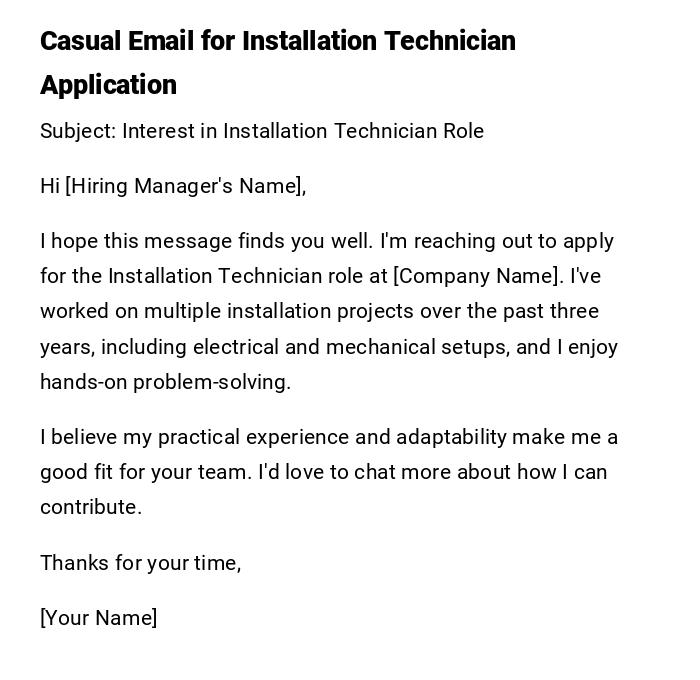
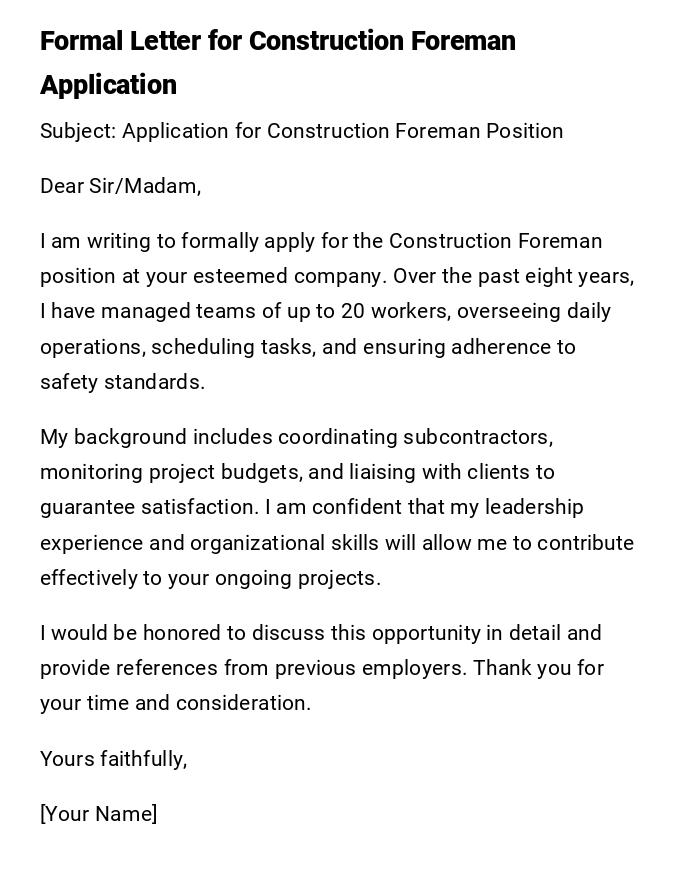
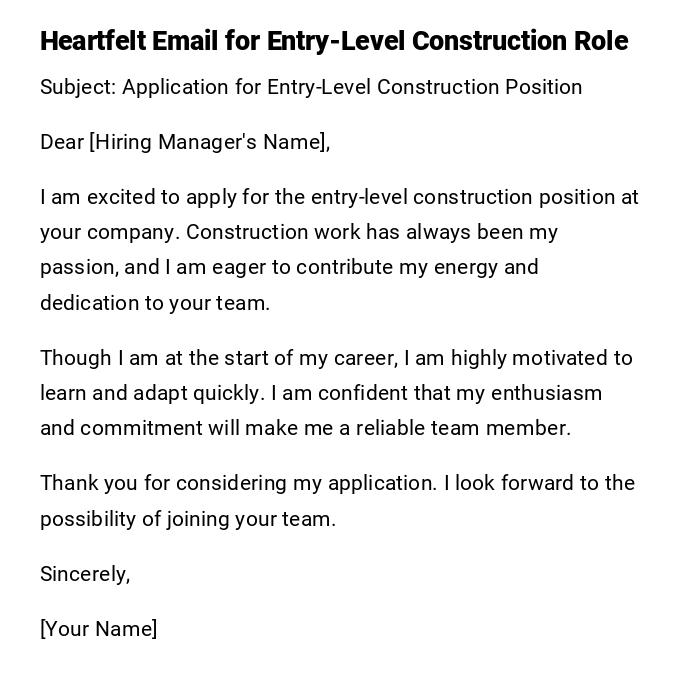
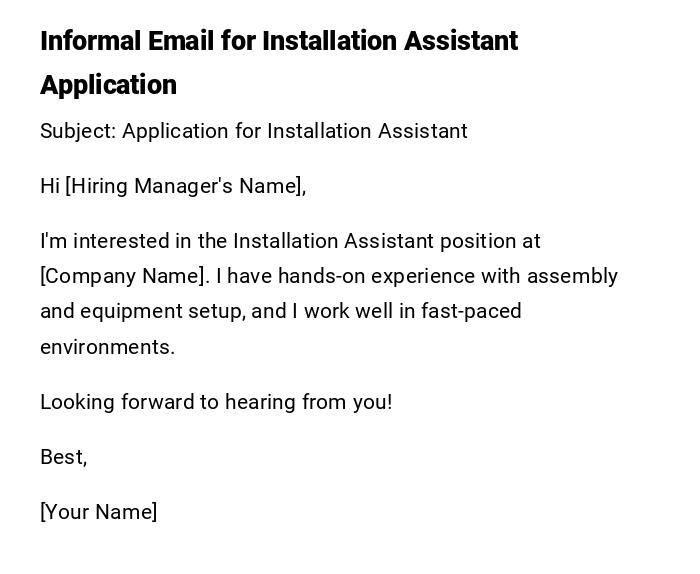
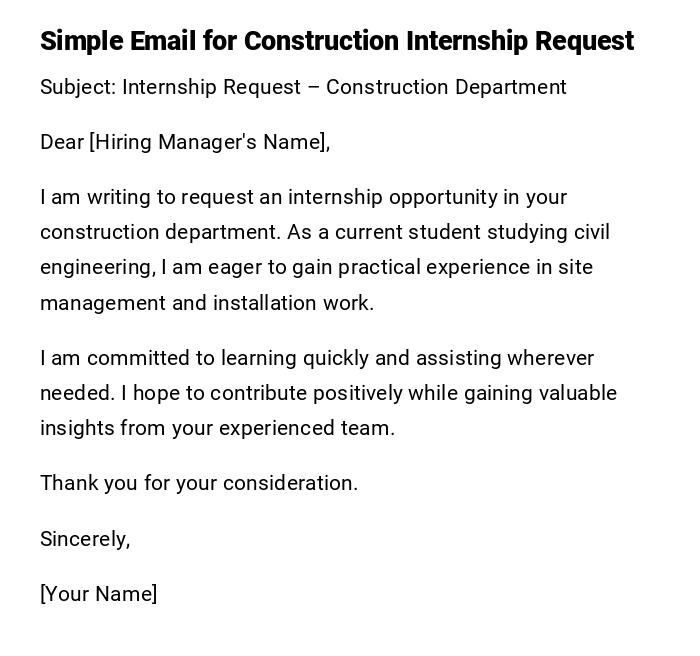
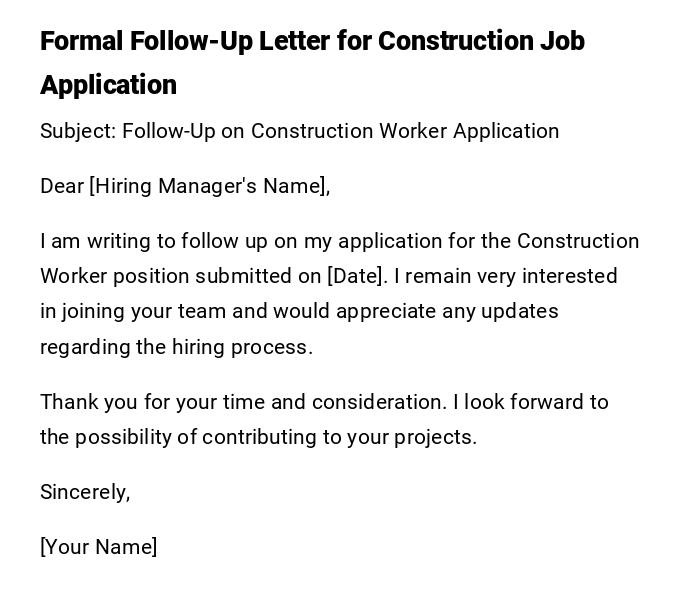

 Download Word Doc
Download Word Doc
 Download PDF
Download PDF